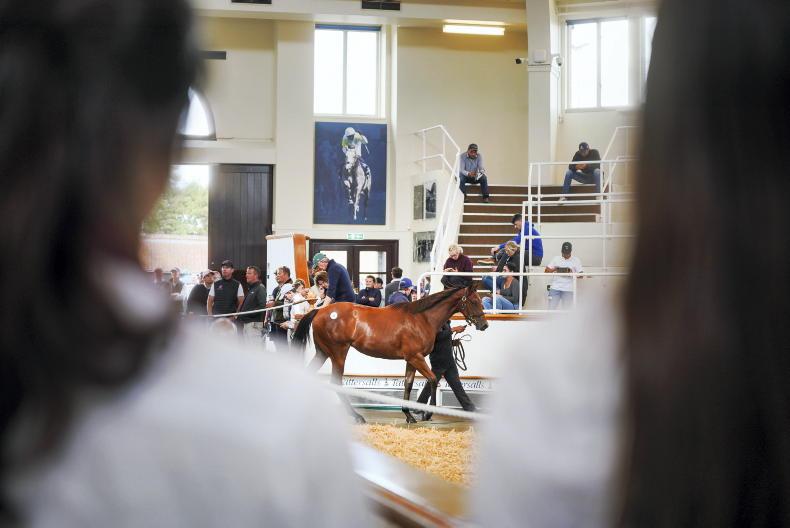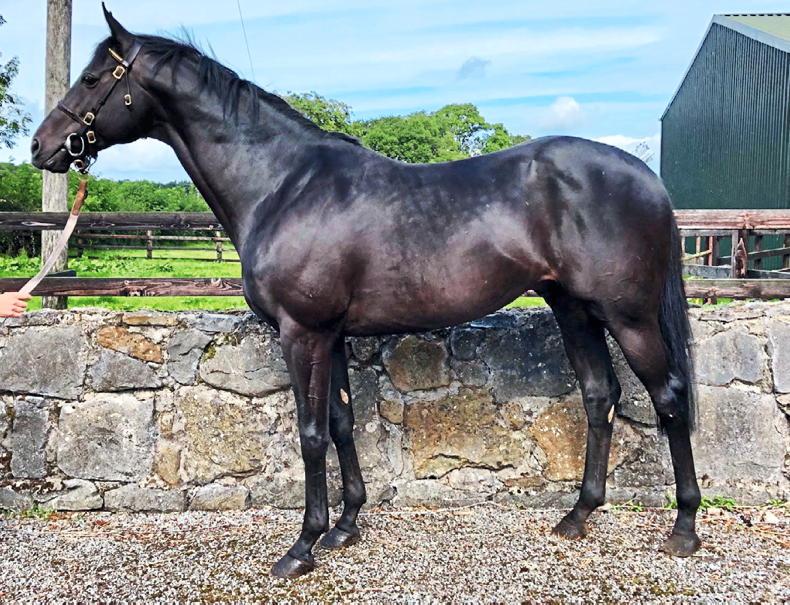To most people in racing and breeding Weatherbys Ireland is the company that registers your new foal in the General Stud Book and issues passports. But there is an awful lot more going on at the company’s Irish headquarters just outside Naas.
They’ve more than a 40-strong team in the office, consisting of laboratory technicians, stud book administrators and pedigree researchers. The laboratory processes 500,000 samples a year, not only verifying parentage of thoroughbreds but also pioneering DNA testing and genomic services for cattle, sheep, dogs, shrimp and even camels!
Weatherbys may be 250 years old but has been constantly evolving. In Britain, the company has traditionally managed the nuts and bolts during that time - looking after race entries, naming horses, registering owners colours, publishing racecards and other key industry titles etc. Their core responsibilities within racing administration are undergoing significant change with a new joint venture between Weatherbys and the British Horseracing Authority underway and operating as Racing Digital.
Then there’s their bloodstock business which has a database of over two million horses and researches more pedigrees than anyone else globally.
In the Financial Services sector Weatherbys Bank and Weatherbys Hamilton have been making great strides in banking and insurance and look after customers both inside and outside of the thoroughbred world.
Weatherbys is now also a global influencer within the thoroughbred world as it introduces cutting-edge racing and stud book systems to leading international jurisdictions – most recently in Bahrain and Dubai.
So as you can see there are many strings to the Weatherbys bow but closer to home one of the most significant innovations coming out of their ‘stable’ in recent years has been the Weatherbys ePassport. Improving traceability and welfare, the ePassport now covers 200,000 horses in the British and Irish Stud Books.
I spoke to Weatherbys CEO Russell Ferris and Weatherbys Ireland general manager Sharon O’Regan about the ePassport and the business’s other recent innovations and future plans.
Q: The past few years has seen a huge amount of change in racing and breeding administration. How has Weatherbys adapted?
Russell Ferris: In the last three or four years we have moved through Brexit. Weatherbys was and is very much involved in those conversations with Horse Racing Ireland, the Irish Horseracing Regulatory Board and the Irish Thoroughbred Breeders’ Association. We were supporting those organisations in terms of horse health certification and the new cross-border implications. Alongside the TBA and BHA, we were also a founding member of the Thoroughbred Industries Brexit Steering Group in the UK.
So we were vital in those bipartite conversations and helped bring it to a position where the ePassport is going to be fundamental to the easy transit of animals between the UK and Ireland, and hopefully into France and other EU countries.
Q: What effect did Covid have on Weatherbys and its clients?
RF: Covid had a massive impact on racing administration, and our other critical functions, obviously not just in Ireland but in Britain too. Like most office businesses, we moved a lot of people off-site but we still continued to service and operate our business and ensure that passports were printed, catalogues went to market, and people could still trade and move horses. The prices that were achieved through that period were phenomenal.
We discovered that, post-Covid, we can work more closely with our UK counterparts without constantly commuting. We have Michelle Fogarty now managing our UK General Stud Book team from Ireland. Never before has that happened. It shows the transition in the business and the ability to be flexible and agile.
Sharon O’Regan: I think the ‘Return to Racing’ protocol helped in terms of mandatory requirements for digital solutions, including passports and vaccinations. Covid made everybody realise that digital had to be an option, whether that was for doctors’ appointments or shopping. It’s no different in racing and breeding.
And we were lucky in that we had been doing a lot of work in that space anyway. So it really helped then when we sat down with the regulators and HRI and said, ‘What can we do to make sure we get this sport back, even behind closed doors?’
The answer was very much digital. The ePassport was intended to be primarily an identity document but we flipped it and made it into a regulatory tool for racing and managing that pre-clearance for vaccination and entry and declarations.
We all had to adapt and the regulators adapted. In fairness to the trainers, they all got on board. Being able to clear 125 passports before the horses had even turned up at the races, that eliminated a lot of risk and extra hassle. We now have zero horses on raceday that are non-runners due to a vaccine issue. Before you would occasionally hear an announcement at the track that a horse was withdrawn due to a passport irregularity, usually over a vaccination. We don’t get that anymore and that’s purely down to digital.
Q: How would you say Irish breeders have adapted to the changes required of them when registering foals?
RF: We moved online with foal registration in 2017. We went from 10,500 foals being registered in paper documentation to having 60% online in year one. Pretty much at this point it’s 95% all compliant with registration going through our system.
Once we onboarded the breeders, the ability for them to administer and document their registration is much, much simpler. The process in terms of how you report your animals, how you log your data, a lot of that is now pre-entered and pre-validated so it’s much easier than the old way of having to fill in a form from scratch for each individual animal.
Q: So it’s much more efficient now?
RF: Yes, and much more user-friendly than doing it manually. I think there’s always a hesitancy around digital deployment but fundamentally we had been looking at this through the eyes of the customer as much as through the eyes of the administrator. We know what breeders have been doing because we have been receiving registrations for over 100 years. So we knew how to make the journey easier for them and for us. I think it’s been a win-win in that respect.
SOR: Yes, 95% of foals will be registered online this year and each one of those foals will have access to a digital passport now. Globally we are the only stud book that offers a digital passport alternative, where you will get a paper passport for your animal, as per the legislation, but you will also get access to a digital passport and you can track and capture information in that.
For the breeder and the industry, that is massive because you can track the foals throughout their life, their ownership, movement and health information. They can do that all now and it’s instant. The information is back in the main database that we have here as opposed to having to post the passport in here and that waiting for us to post it back to you.
Q: So traceability of thoroughbreds has improved, but are there still loopholes? Could someone be listed as the horse’s keeper when in fact they no longer have the horse?
SOR: We’re looking at this with John Osborne’s department in Horse Racing Ireland. The vast majority of the time, Weatherbys would have visibility of an animal, where they are, what they are doing. But there are always those gaps, like before they go into training or if they are being pinhooked, you know, so definitely I think there’s areas for us to improve on. But the technology will advance and make that so much simpler.
Both from an end-user perspective and for us as an industry, it is important for us to be able to defend that welfare position by saying ‘we know where the majority of our horses are and we know who is caring for them’.
RF: I think it is also an education piece. No matter what you do digitally now there’s always going to be an element of education on how we bring the industry along with that. As Sharon said, we may know a horse’s whereabouts most of the time but we want to get to a position where the ePassport becomes from a legislative perspective a more accepted form of communication.
We are still working to European legislation and, although the ePassport is accounted for within legislation, it is not to the level of intelligence or functionality we have developed, nor is there current provision in respect of removing the paper passport document. This is to ensure standards across all 27 members states but it should not be a blocker to rolling out an ePassport in those EU countries who can support digital solutions and integration with data systems
We are releasing new elements to it in 2023, which again will help us to progress that engagement with the breeder, that will provide better data and better services back for Government. But we have to really work in parallel at the moment.
In an ideal world you would remove your paper passport and only print that document when you have to move to a location that requires it, like France or Germany. But we would operate and manage our herd book in Ireland on an ePassport. Because that gives a much better oversight of the animal population in Ireland and allows the authorities to further improve the traceability and welfare for our equine population. So that’s the bit we are trying to get to.
That’s all about engagement and education. Fundamentally at the moment we are running a parallel universe which is difficult for our breeders to understand. For example, the ePassport can record a horse’s death, so that identity document could not be used again. That’s fundamentally what we need for traceability and welfare.
SOR: In fairness to the Department of Agriculture, they see the benefit of going digital and have been very supportive. They have carried out an equine census for the past two years and are aware there are grey areas around traceability.
Q:We’ve seen cases, not just in thoroughbreds, of falsified passports and duplicated or cloned chips. How can this be prevented?
RF: That gap can be closed with technology. The next potential advance is the biological passport. We already identify DNA markers in horses at the moment to verify parentage. In the future there will be technologies that allow us to read the parentage of a horse within one hour of extracting a blood sample. You can forge a passport, you can clone a chip but you can’t change the DNA. So that’s the next level where we’ll potentially get to.
Q: There was an Oireachtas hearing last year where politician after politician spoke up about the strength of the cattle identification system in this country and how the equine system was way behind. Is that true?
SOR: No. In fact you could say the thoroughbred breed is streets ahead in terms of parent verification. The thoroughbred’s identity is checked so many times – at sales, in competition, when it’s being moved. So we are fairly robust.
RF: I think the thoroughbred is certainly the pinnacle, and that’s because of the horse’s value. With the ePassport we are cataloguing lifecycle events and putting it in one document that we can actualy interrogate, so it’s a wonderful place to be. Other species that Weatherbys work with are not at that level yet. We are certainly way ahead, a good bit ahead of some of the others.
Q: We’re increasingly hearing about racing’s social licence and how welfare issues can threaten the whole future of the sport and industry. Does Weatherbys have a role to play in protecting racing’s social licence?
SOR: It’s all about that integrity and sustainability for the sport really, isn’t it? We’re lucky we have good relationships with HRI, the IHRB and the ITBA. We’re all about protecting the integrity of racing and keeping it sustainable, whether the threat is Covid, Brexit or a BBC investigation. In recent times we’ve seen the industry work together in ways it never did before.
RF: In some respects you see more of a focus on certain welfare issues in Britain that you do in Ireland. I can see that having worked in both countries. We have to keep ahead of changes in society and how we are perceived. It’s not just about the use of the whip. It’s the ways we manage and look after our horses, our medication rules, the after-racing care.
As a breeder myself, every one of us involved in the sport has a social responsibility to make sure we protect racing. Weatherbys has a part to play in terms of how we manage those lifecycles, how we innovate and drive change, create a more digital environment, give more data, understand what’s happening with the horse, where the horse is moving to, how it’s being moved, whose responsibility is it, and so on.
If we can provide better services and better processes which allow organisations such as HRI to make better decisions then we have a part to play. I think we will only succeed as an industry if we all walk in the same direction.
I think the biggest risk to us is actually people’s perception and attitudes towards using animals for performance, for our enjoyment. That’s the fundamental thing. So take that as the end point and then work your way back.
We’ve got a social responsibility to do what we can to make sure that, hopefully, in 50 years’ time we have a viable enterprise that still has 30,000-plus people employed and generating billions in economic activity each year.
SOR: Even moving horses around, think about the cost of that in terms of carbon footprint. That’s something which is going to come under more scrutiny in the future from an environmental perspective.
A later article will cover Weatherbys’ expansion into the Middle East, how they deal with ownership disputes, and why breeders should not leave it to the last minute to register foals.


 This is a subscriber-only article
This is a subscriber-only article
 It looks like you're browsing in private mode
It looks like you're browsing in private mode















SHARING OPTIONS: